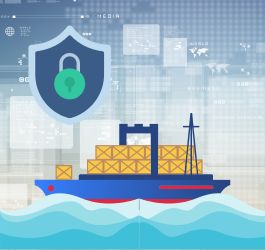
In the past two decades, the global maritime shipping and port sectors have witnessed remarkable expansion. Notably, containerized trade has seen a substantial surge, soaring from approximately 60 million 20-foot equivalent units (TEUs) transported in 2000 to surpass 140 million in 2020.
Concurrently, the overall volume of international maritime trade has nearly doubled, surpassing 11 billion tons annually. According to the Organisation for Economic Co-operation and Development (OECD), over 90% of internationally traded goods traverse the seas.
Seaborne trade presently constitutes about 80% of the total volume of global trade each year and contributes to 70% of its overall value. Forecasts suggest that maritime trade volumes will triple by 2050, underscoring its ever-growing importance.
The substantial expansion of the shipping industry has led to a significant increase in greenhouse gas (GHG) emissions, which play a pivotal role in climate change.
Presently, the shipping sector is responsible for approximately 20% of global emissions originating from the transportation sector.
This substantial carbon footprint is attributed not only to the sheer volume of goods transported annually via sea routes, but also to the fact that shipping heavily relies on energy derived from bunker fuels, which are relatively emissions-intensive.
However, much like other economic sectors, it confronts a dual challenge in the face of climate change: the imperative to diminish its contribution to global warming while simultaneously adapting to the repercussions of climatic shifts.
Table Of Contents
- What is climate change?
- The vulnerability of ports to climate change
- Navigating environmental challenges
- The 6 impacts of climate changes on maritime industry
- Rise of sea level
- Extreme weather events
- Impact on shipping routes
- Infrastructure vulnerability
- Supply chain disruptions
- Economic costs
- How maritime industry prevent climate changes
- Greener fuel selection
- Operational improvements
- Technical innovations and refinements
- Energy efficiency measures
- Regular maintenance and inspection
- Final thoughts
What Is Climate Change?

Climate change, in its essence, encompasses the enduring alterations in temperatures and weather patterns over extended periods. These shifts can arise from natural causes, such as variations in solar activity or significant volcanic eruptions.
However, since the 1800s, human activities have become the predominant catalyst for climate change. This is primarily attributed to the extensive combustion of fossil fuels like coal, oil, and gas.
The combustion of fossil fuels serves as the primary source of greenhouse gas emissions. These emissions act akin to a blanket enveloping the Earth, capturing and retaining the sun's heat within the atmosphere.
Consequently, this process contributes to a gradual rise in global temperatures. This phenomenon is at the core of contemporary climate change concerns, as it has far-reaching implications for the environment, ecosystems, and human societies.
In a series of United Nations reports, a consensus among thousands of scientists and government reviewers emerged: capping global temperature increase at a maximum of 1.5°C stands as a crucial threshold to avert the most catastrophic climate impacts and sustain a habitable planet.
However, current policies indicate a trajectory towards a 2.8°C temperature rise by the close of this century. The emissions responsible for climate change originate from every corner of the globe, impacting people worldwide. Yet, certain nations contribute significantly more than others.
The seven largest emitters — China, the United States of America, India, the European Union, Indonesia, the Russian Federation, and Brazil — alone were responsible for roughly half of the global greenhouse gas emissions in 2020.
While it is imperative for everyone to engage in climate action, it is undeniable that those nations and entities generating a substantial portion of the issue bear a heightened responsibility to take the lead in mitigating their emissions.
By reevaluating our collective approach to emissions, and with an emphasis on accountability, we can work towards a more sustainable and equitable global climate strategy.
The Vulnerability Of Ports To Climate Change
Ports which serve as vital gateways for global trade and commerce, find themselves at the forefront of the impacts of climate change.
Their vulnerability primarily arises from their coastal locations, which render them susceptible to rising sea levels and the increasing frequency of extreme weather events associated with climate change.
As sea levels continue their inexorable rise, ports face critical challenges related to their structural integrity. While the gradual nature of sea-level rise might deceive some into thinking its effects are manageable, the reality is far graver.
Ports rely on the predictability and stability of ocean currents for efficient operations. As sea levels encroach upon port areas, companies must consider moving further inland to safeguard their operations.
However, this inland shift is no simple solution. Ports require immediate land proximity for various critical activities, including cargo storage, warehousing, and efficient freight handling. These operations are highly dependent on stable weather conditions and dry land.
Addressing the profound challenges posed by rising sea levels and climate change necessitates not only rethinking building and infrastructural practices but also adopting a comprehensive and proactive approach.
The resilience of port facilities hinges on innovative strategies, sustainable design, and a united effort to confront climate change's multifaceted impacts on this pivotal sector of the global economy.
Navigating Environmental Challenges
The maritime shipping industry, in particular, will be among the most affected sectors by our failure to achieve climate neutrality. The most evident consequence is the global shift in temperatures, but it's crucial to understand why.
As more greenhouse gasses accumulate in the atmosphere, an increasing amount of solar heat becomes trapped within the Earth's confines. Oceans play a pivotal role in absorbing this radiant heat, leading to a rise in ocean temperatures.
These temperature fluctuations subsequently trigger shifts in ocean currents, causing significant alterations in climate patterns on a global scale. The repercussions of warmer waters are substantial. They lead to the intensification of storms, the proliferation of low-pressure areas, and the buildup of powerful gale-force winds.
For the shipping industry, storms present a formidable challenge to its operations. Even with mega-freight containers, which are akin to small towns in size, storms can significantly disrupt shipping routes.
Routes rendered impassable due to extreme weather conditions can be highly problematic. Storms necessitate detours or even longer routes, adding both time and cost to shipping endeavors.
Sailing through a hurricane is not an option, as it endangers both crew members and cargo. Even a single day of delay in shipping operations triggers a domino effect that can reverberate throughout the entire freight process, causing extensive delays and economic implications.
This challenge is expected to intensify further due to the warming of ocean temperatures and rising sea levels attributed to climate change, resulting in more intense and devastating hurricanes and tropical storms.
Estimates from the High Meadows Environmental Institute suggest that the percentage of Category 3 to 5 cyclones has increased by approximately five percent per decade since 1979.
The 6 Impacts Of Climate Changes On Maritime Industry
To comprehend the ramifications of climate change, it's imperative to grasp its influence on offshore weather conditions and the vital elements within the industry.
Acknowledging that human activities have significantly contributed to these changes underscores the responsibility we bear in rectifying them.
1. Rise Of Sea Level

With the persistent rise in global temperatures, further sea-level increase is an undeniable reality. The extent and pace of this rise hinge primarily on the trajectory of future greenhouse gas emissions.
However, an additional source of uncertainty lies in the behavior of colossal ice sheets in Antarctica and Greenland. Rest assured, the dynamics of these ice sheets hold significant implications for future sea-level projections.
The escalating sea levels driven by the effects of climate change have profound consequences for the global shipping industry. A study stated that the escalation of sea levels could lead to a heightened risk of recurrent port flooding and even jeopardize the integrity of existing infrastructure.
Firstly, glaciers and ice sheets across the globe are undergoing melting processes, thereby augmenting the volume of water in the oceans. Secondly, the ocean's volume is expanding as the water temperature increases.
A third, though comparatively minor, factor influencing sea level rise is a reduction in the quantity of liquid water on land—this includes aquifers, lakes, reservoirs, rivers, and soil moisture. This shift of liquid water from land to ocean is primarily attributed to extensive groundwater extraction.
When combined with storm surges, land-based flooding, and the increasing occurrence of severe sea cyclones, these rising seas present significant challenges to the safety and efficiency of shipping operations.
2. Extreme Weather Events

Climate change is linked to an increase in the frequency and intensity of extreme weather events such as hurricanes, typhoons, cyclones, and severe storms.
Natasha Brown, acting head of public information services at the International Maritime Organization (IMO), has underscored that climate change has led to a higher frequency of extreme weather events, posing significant threats to livelihoods, particularly in vulnerable communities.
Extreme weather phenomena have the potential to disrupt trade routes significantly, necessitating route adjustments to mitigate disruptions and delays. In severe cases, these events can lead to the loss of cargo or damage to vessels.
Powerful winds, heavy rainfall, rough seas, and high waves make navigation dangerous and can lead to delays, damage to vessels, and loss of cargo.
3. Impact on Shipping Routes

Changing weather patterns can alter traditional shipping routes. Melting ice in the Arctic, for example, is opening up new northern shipping routes, but these routes come with their own challenges and risks due to the presence of icebergs and unpredictable weather.
Furthermore, changes in ocean conditions can impact the stability and safety of shipping routes. Warmer waters may lead to more intense and unpredictable weather patterns, affecting vessel navigation and safety protocols.
These shifts necessitate careful monitoring and adaptation by the maritime industry to ensure safe and efficient global trade operations.
Hence, due to the altered safety and navigability of established routes, the necessity for charting new courses arises. This shift in routing can prove to be highly inconvenient and hamper productivity for both customers and shipping lines.
It demands a significant allocation of time and financial resources for planning routes, diverting resources from regular operations. For customers, the extended transit times can impact the timeliness of their deliveries.
4. Infrastructure Vulnerability

Storm surges, resulting in floods, can dramatically impair the functionality of numerous port facilities. Even after the storms abate, flooding may persist, impeding port operations for an extended period.
In the event of a natural disaster striking a port, the potential for extensive damage is significant, to the extent that the port may become completely non-operational.
Hurricane Katrina serves as a poignant example, inflicting over $250 million in damage to the Port of Gulfport along with the ships and cargo within it.
Port closures or damages can send shockwaves through the global supply network. Ships are the lifeline for transporting vast quantities of essential economic commodities like oil and food.
Any interruption or curtailment in their movement can have far-reaching and adverse impacts, disrupting the flow of these critical resources on a global scale.
This disruption can result in a notable loss of labor productivity, as workers find themselves unable to carry out their tasks in waterlogged or damaged areas.
5. Supply Chain Disruptions

The maritime transport sector has encountered a series of disruptions, significantly impacting global supply chains and logistics. Industrial actions and labor strikes have emerged in key ports worldwide, including Germany, the Republic of Korea, South Africa, and the United Kingdom.
Simultaneously, a string of extreme weather events, ranging from floods to hurricanes and heatwaves, have struck various regions like Australia, Brazil, Pakistan, East Africa, Europe, and the United States.
These compounding challenges create compounding issues for maritime trade. Since the fourth quarter of 2022, there has been a downward revision in projected global economic growth. Concerns have arisen that the world economy may face the risk of slipping into a state of recession and stagflation.
This scenario underscores the critical importance of addressing and mitigating the multifaceted challenges faced by the maritime industry to safeguard the stability of global trade and commerce.
Primarily, a significant segment of the shipping industry depends on the uninterrupted flow of goods and materials. Storms, accompanied by high winds and towering waves, can expose shipping personnel to perilous situations and bring operations to a standstill.
In the midst of severe weather events, productivity frequently experiences a sharp decline, leading to prolonged periods of downtime and substantial financial setbacks.
6. Economic Costs

The maritime industry is a significant contributor to the global economy. Climate-related disruptions can result in increased shipping costs, insurance premiums, and losses due to damaged or lost cargo.
According to a nonprofit research institute affiliated with the Environmental Defense Fund (EDF), it was estimated that "unless further measures are taken to decrease emissions, the shipping industry could face an extra $25 billion in climate change-related costs annually by the year 2100."
Furthermore, the aftermath of extreme weather events necessitates additional expenditures for repairs, restoration efforts, and, in some cases, the relocation of facilities. These costs can ultimately affect consumers through higher prices for goods.
Instead of concentrating on the critical task of efficiently moving cargo along designated routes, management may find themselves allocating valuable time and resources to recovery and rehabilitation endeavors.
In light of these formidable challenges, the shipping industry must take proactive steps to adapt to the evolving climate.
This includes investing in resilient infrastructure, implementing enhanced storm preparedness plans, and making worker safety a top priority during adverse weather conditions.
By addressing these concerns, the industry can mitigate the adverse impacts of climate change, ensuring its productivity and sustainability in an ever-changing global landscape.
How Maritime Industry Prevent Climate Changes

Numerous climate change solutions not only address environmental concerns but also offer substantial economic advantages and enhance our overall well-being.
These solutions align with global frameworks and agreements, including the Sustainable Development Goals, the UN Framework Convention on Climate Change, and the Paris Agreement.
They fall within THREE overarching categories:
Implementing strategies to lower greenhouse gas emissions is a fundamental step. This includes transitioning to renewable energy sources, enhancing energy efficiency, promoting sustainable transportation, and adopting cleaner industrial practices.
Recognizing that climate change impacts are already occurring, adapting to these changes is crucial. This involves initiatives like fortifying infrastructure against extreme weather events, developing drought-resistant agriculture, and implementing coastal protection measures.
Adequate financing is necessary to facilitate the transition towards a sustainable, climate-resilient future. This encompasses investments in green technologies, supporting climate-smart agriculture, and funding research and development for innovative climate solutions.
By strategically focusing on these areas, we can not only combat climate change but also foster economic growth, improve societal well-being, and safeguard the environment for future generations.
Shipping companies have a range of options at their disposal to improve a ship's environmental performance and minimize its carbon footprint.
These measures are crucial not only for reducing emissions but also for adapting to extreme weather conditions and ensuring the sustainability of the maritime industry:
1. Greener Fuel Selection

Climate change is compelling the shipping industry to reconsider how it manages its resources, with a critical focus on fuel usage. The environmental impact of oil spills has become increasingly pronounced, accentuated by the exacerbating effects of climate change.
Transitioning to cleaner and sustainable fuels is a primary strategy to meet climate goals. Liquified natural gas (LNG), biomethanol, hydrogen, and ammonia are environmentally friendly alternatives to traditional heavy fuel oil.
Each type of renewable fuel comes with its own set of advantages and challenges, making it crucial to evaluate factors such as the entire supply chain, engine compatibility, environmental impacts, and production costs.
Companies can retrofit existing vessels to use these fuels or invest in new ships designed for cleaner energy sources.
The cost-effectiveness and availability of these alternative fuels will play a pivotal role in determining their widespread adoption. Key determinants of the costs include the availability and cost of the feedstock, the production process, and the maturity of the technology involved.
2. Operational Improvements

Implementing operational changes is crucial for optimizing a ship's performance and curbing emissions.
This involves route optimization to minimize fuel consumption, adjusting vessel speeds to enhance fuel efficiency, and adopting just-in-time arrival strategies to reduce idle time at ports.
Moreover, ensuring proper hull maintenance and cleaning can significantly decrease fuel consumption by mitigating drag.
In light of the increasing frequency and intensity of storms, ships at sea will be compelled to implement adaptation strategies, primarily through re-routing.
However, this essential adjustment comes at a cost, resulting in heightened delays and increased operating expenses.
3. Technical Innovations and Refinements

Progress in ship design and equipment is instrumental in enhancing environmental sustainability.
The retrofitting of ships with energy-efficient technologies, such as advanced propulsion systems, exhaust gas cleaning systems (scrubbers) to reduce sulfur emissions, and waste heat recovery systems, holds the potential for significant fuel savings and emissions reduction.
Additionally, the modernization of engines and propulsion systems presents another avenue to achieve these objectives.
These initiatives not only foster a more eco-friendly industry but also align with global endeavors to combat climate change and diminish the environmental impact of maritime operations.
4. Energy Efficiency Measures

Embracing onboard energy efficiency practices, including the adoption of LED lighting, optimized HVAC systems, and efficient energy management systems, can significantly reduce power consumption andemissions.
Furthermore, the maritime industry can spearhead investments in cutting-edge technologies like zero-emission hydrogen or ammonia fuel cells, along with battery-electric propulsion systems.
These innovations hold particular promise for short-distance shipping routes.
5. Regular Maintenance and Inspection

Ensuring ships are well-maintained, regularly inspected, and promptly repaired is essential for preventing leaks, reducing emissions, and extending vessel lifespans.
When ordering new vessels, companies can prioritize sustainable ship design principles, including optimized hull designs, energy-efficient engines, and the use of materials with a lower environmental impact.
By adopting these measures, shipping companies can not only reduce their carbon footprint but also enhance their readiness to operate safely in the face of extreme weather conditions.
These steps contribute to the overall sustainability and resilience of the maritime industry, aligning it with the challenges posed by climate change and ensuring its long-term viability.
Final Thoughts
The shipping industry, responsible for over two-thirds of the world's trade value, is facing growing challenges from climate change. Without decisive action, we risk witnessing the global economy face a stormy decline, one tempest at a time.
Ultimately, in our perspective, the most intriguing repercussion of climate change on the shipping industry lies in the transformation of the global economic trade dynamics and the reconfiguration of shipping routes. This evolution is set to reshape the very essence of maritime commerce.
As climates undergo transformation worldwide, the suitability of local food production will experience significant shifts from equatorial regions towards both higher and lower latitudes. This transition will mark a substantial change in the dynamics of food production and availability.










